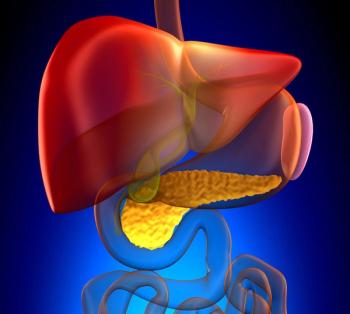
Combination of Atezolizumab Plus Cabozantinib Shows Meaningful Activity for High-Risk mCRPC
Atezolizumab plus cabozantinib showed significant activity for patients with high-risk metastatic castration-resistant prostate cancer.
For previously treated patients with locally advanced or metastatic castration-resistant prostate cancer (mCRPC), including high-risk clinical features, cabozantinib (Cabometyx) plus atezolizumab (Tecentriq) continued to show clinically significant activity, according to results from the phase 1b COSMIC-021 trial (NCT03170960) presented during the
The data included 132 patients, all of whom had prior enzalutamide (Xtandi) and/or abiraterone acetate (Zytiga), and 101 (77%) of whom had high-risk disease. At the data cutoff of February 19, 2021, the investigator-assessed objective response rate (ORR) among all patients was 23%, including 3 complete responses (CRs); the ORR was 15% (all partial responses [PRs]) per independent review.
The investigator-assessed ORR in high-risk patients was 27%, comprising a 2% complete CR rate and a 25% PR rate. Per independent review, the ORR was 18%, comprising all PRs.
At a median follow-up of 15.2 months (range, 5.7-33.9), the median PFS per independent review was 6.8 months in high-risk patients and 5.7 months in the overall population. The median overall survival (OS) was 18.4 months in both the overall and high-risk populations. Based on available data from 75 patients, initial results did not indicate a link between tumor PD-L1 status and clinical activity.
“These detailed results confirm previous findings3 from cohort 6 of COSMIC-021, further suggesting the promise cabozantinib in combination with atezolizumab may hold for patients with high-risk metastatic castration-resistant prostate cancer whose disease progressed following treatment with novel hormone therapy,” Neeraj Agarwal, MD, professor of Medicine, Huntsman Cancer Institute, University of Utah and a trial investigator, stated in a news release.
“A significant number of these patients are looking for treatment options beyond chemotherapy, so these clinically meaningful response rates and progression-free survival results of cabozantinib in combination with atezolizumab are encouraging for this patient community and their physicians,” added Agarwal.
The multicenter, open-label, phase 1b COSMIC-021 trial is evaluating the combination of the PD-L1 inhibitor atezolizumab and the multikinase inhibitor cabozantinib in patients with locally advanced or metastatic solid tumors. The mCRPC cohort is cohort 6 of the trial. Patients in this cohort were allowed to have received prior docetaxel for hormone-sensitive disease. The study design defined high-risk disease as measurable visceral and/or extra-pelvic lymph node metastases. Cabozantinib was administered orally at 40 mg once daily and intravenous atezolizumab was given at 1200 mg every 3 weeks. The primary end point was ORR.
The median patient age was 70 years and 52% (n = 68) had an ECOG performance score of 0. Overall, 42 (32%) patients had visceral metastases and 79 (60%) patients had extra-pelvic lymph node metastases. Regarding prior treatment, 25% of patients had received docetaxel and almost half (45%) of patients had received 2 or more novel hormonal therapies.
The median follow-up time in the high-risk subgroup was 15.8 months. In these patients, the disease control rate was 88% per investigator assessment and 84% per the assessment of the BIRC.
There were no new safety signals that emerged in this updated, expanded cohort analysis as compared with the initial interim analysis. The most common treatment-related adverse events (TRAEs) were diarrhea (55%), nausea (42%), fatigue (43%), and decreased appetite (34%). Over half (55%) of patients experienced grade 3/4 TRAEs. There was 1 reported death related to a TRAE (dehydration in a 90-year-old patient).
Phase 3 CONTACT-02 study
Exelixis, the developer of cabozantinib, reported in a news release that based on discussions with the FDA, they will not be filing for regulatory approval of the combination based on the cohort 6 data from COSMIC-021. Instead, the company has launched the phase 3 CONTACT-02 trial (NCT04446117). This ongoing randomized, open-label, study is exploring cabozantinib plus atezolizumab versus second novel hormone therapy (abiraterone, enzalutamide, etc) in patients with mCRPC who previously received 1 NHT to treat metastatic castration-sensitive prostate cancer, non-metastatic CRPC, or mCRPC.
Primary outcomes measures for the trial are OS and PFS, with ORR as a secondary outcome measure. The target enrollment is 580 patients, and there are 62 study locations for the trial in the United States and worldwide. Exelixis noted in their news release that results of this study may support regulatory submissions for the cabozantinib/atezolizumab regimen.
References
1. Agarwal N, McGregor BA, Maughan BL, et al. Cabozantinib (C) in combination with atezolizumab (A) in patients (pts) with metastatic castration-resistant prostate cancer (mCRPC): Results of expanded cohort 6 of the COSMIC-021 study. Presented at: 2021 European Society for Medical Oncology Congress. September 16-21, 2021. Abstract LBA24.
2. Exelixis Announces Detailed Phase 1b Results from Cohort 6 of COSMIC-021 Trial in Patients with Metastatic Castration-Resistant Prostate Cancer Presented at ESMO 2021. Published online September 18, 2021. Accessed September 18, 2021. https://yhoo.it/3CvZG2N.
3. Agarwal N, Loriot Y, McGregor BA, et al. Cabozantinib in combination with atezolizumab in patients with metastatic castration-resistant prostate cancer: Results of cohort 6 of the COSMIC-021 study. J Clin Oncol 38: 2020 (suppl; abstr 5564). doi: 10.1200/JCO.2020.38.15_suppl.5564.
Newsletter
Stay up to date on recent advances in the multidisciplinary approach to cancer.















































































